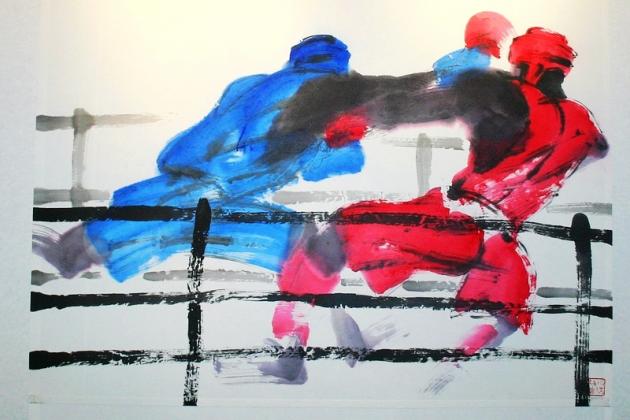
拳击文化在中国拥有悠久的历史
Boxing is a major sport in modern Olympic Games.
In a little more than 10 years since 2004 Olympics, China has grown from a boxing underdog, which had never won an Olympic medal in boxing, to an emerging force in the boxing ring. China's boxing has experienced great evolution and attracted global attention.
拳击是现代奥运会的重要比赛项目。自2004年雅典奥运会,邹市明打破中国拳击在奥运会上的“奖牌荒”开始到现在,短短十余年间,中国已由一个从未夺得过一枚奥运奖牌的拳击弱国,一跃跻身为摘得3金、2银、3铜的新兴拳击强国,中国拳击已获得世界瞩目。
China's Boxing Tradition
中国的拳击传统
In most people's eyes, China is a big nation with little boxing tradition. But in fact, China has a centuries-old boxing history. Yet, it was rather different from boxing today.
在大多数人眼中,中国是一个没有多少拳击传统的国度。然而实际上,拳击文化在中国拥有悠久的历史,只是那时的“中国拳击”与今日的拳击运动有所不同。
The history of China's boxing dates back 3,700 years, when China was in the Late Shang Dynasty, and the sport was one of the subjects for military training conducted by aristocrats.
By the Han Dynasty (206 BC - AD 220), boxing became the mandatory subject for soldiers.
据史料记载,早在3700多年前,当中国还处在殷商时代,拳击运动就已出现在了这片国土上。这项运动那时叫作“斗”,是贵族统治阶级进行军事训练的一个科目。发展到了汉代,拳击成为了军人们必须接受的训练项目。
Unlike boxing of the early times in western countries which was a mixture of both the boxing and wrestling, boxing in China was apparently distinct from wrestling as early as 3.7 thousand years ago.
与西方早期拳击与摔跤混合在一起进行比赛的拳击运动不同,中国的拳击早在商周时代就已与摔跤运动截然分开了。
The book, The Combat Arts of Two Hands, which was written exclusively for boxing, appeared around 2,000 years ago. Unfortunately, this book was not handed down from generation to generation.
Moreover, wearing boxing gloves and protection started in China approximately 700 years ago.
The above shows that China has a long boxing tradition.
此外,在2000年以前,中国就出现了专研拳击的著作——《手搏》,但到隋朝时失传了。而戴护具的拳击运动早在南北朝时期就已经出现在了中国。这些都很好地说明了,中国拥有悠久的拳击文化传统。
Modern Day Boxing
现代拳击运动在中国的发展
Modern day boxing in China, which was initially called "western boxing", was first introduced in the late 1920s in the port city of Shanghai, along with a book, titled The Technique of Western Boxing, which was then translated into Chinese.
中国的现代拳击运动始于20世纪20年代后期的上海,最初被称为“西洋拳”。伴随这项运动一同传入上海的还有一本名为《西洋拳术》的书。这本论述西洋拳击技巧的书随即被翻译成了中文在上海流传。
In the '30s, some sports academies put boxing classes in their major curriculum and fostered a number of Chinese boxing talents.
At this stage, the sport of boxing was mainly carried out in the city's western rental area, where the majority of players were western sailors, soldiers and merchants, only a handful of Chinese took part.
30年代,南京国民政府的中央国术馆、国立国术体育专科学校都将拳击列为主课之一,并培养出了一批拳击人才。在这段时期,拳击运动主要在上海的租界内开展,参与者多为来自西方国家的水手、士兵和商人,仅有少部分中国人参与。
Before the Anti-Japanese War, boxing became prevalent in some port cities of China when the middle schools and colleges founded by Christian and the Catholic Church listed boxing as one of the major subjects in their physical education classes.
在抗日战争前,拳击运动在中国的一些港口城市很盛行,当时教会办的中学和大学都把拳击作为体育课的重要训练项目之一。
In the 1936 Berlin Olympics, China assigned 69 participants, two of which participated in the boxing competitions. However, they were all eliminated in the qualifying matches.
在1936年于德国举行的第十一届奥运会上,中国派出了69人参赛,其中包括两名拳击手,但他们都在预赛中即遭淘汰。
By the start of the Japanese invasion, western professional boxers began to withdraw from China, and the number of local fighters grew.
The professional bouts at the time were limited to four, six, eight or ten rounds, at maximum, which was for the championship fight.
抗日战争开始后,西方职业拳手逐步撤离中国,中国当地拳手数量开始逐渐增加。那时的职业拳赛一般都规定在四、六或八个回合,只有拳王争霸赛定为十个回合。
In the early 1940s, boxing agents began to show up.
It was reported that one local fighter received a maximum premium of 4,000 yuan (approximately $570 US) for a single bout.
40年代早期,中国开始出现了拳击经纪人。那时,一位中国拳手一场拳赛最多可以获得4000元的收入。
After the liberation war, various forms of boxing matches were held in such big cities as Beijing, Shanghai and Tianjin.
解放后,各类拳击比赛开始在北京、上海、天津等大城市举行。
Probably one of the grandest boxing pageants in Chinese history — 20-city boxing championship with the total number of competitors of 142 was staged in Beijing in 1958.
Judging from the case in this period, the number of athletes taking part in assorted boxing matches was growing, and the host region of boxing was becoming larger and larger.
1958年,中国拳击史上规模最大的一次盛会——20城市拳击锦标赛(实际参赛为21个城市)在北京召开。有142名拳手参加了比赛,获得团体总分前三名的是上海队、北京队和天津队。从过去历届比赛情况看,参加拳击比赛的城市和地区越来越广,选手也越来越多。
Although there were no international Chinese boxing champions up until the '60s, the national tournaments held in this period laid the foundation in China for future development of the sport.
虽然,直到60年代以前都一直没有在中国举办过国际性的拳击比赛,在这一时期举办的全国性比赛为中国拳击运动的未来发展打下了基础。
The Boxing Tragedy
拳击悲剧
In 1959, the first National Games — which was the biggest domestic sports event in China — was held, and the Committee once listed boxing in the National Games' lineup.
However, due to the Great Leap Forward of this sport and its violent nature, a number of incidents concerning serious physical injuries of participant occurred. After several incidents, the committee felt that it was not the right time to develop boxing in such a large scale. Consequently, they temporally removed boxing from the National Games.
In March of the same year, boxing was outlawed by the government as a result of several unannounced reasons.
1959年,第一届全运会筹备委员会曾将拳击作为大会竞赛项目,但由于体育运动的“大跃进”,各省市为了在第一届全运会上“放卫星”,作贡献,盲目发展拳击运动,出现了伤亡事故。后来,组委会感到大规模全国性拳击比赛条件还不成熟,就暂时撤销了这个比赛项目。1959年3月,由于种种原因,拳击运动被宣布暂停开展。
As Hong Fan, a scholar who specializes in China's athletic history, puts it, "People believed that boxing was very brutal, very ruthless. So it was banned."
就如一位专门研究中国体育史的学者所言,人们认为拳击运动非常野蛮血腥,因此这项运动遭到禁止。
Resurrecting the Fight
重获新生
Two decades later, boxing was revived in China. The philosophy of the "Ping Pong Diplomacy" triggered the restoration of the fight game.
这一禁就是20年。20年后,拳击运动在中国重新获得了生命。颇具传奇色彩的是,是“乒乓外交”的理念促成了这项运动的重获新生。
In December 1979, the former undisputed heavyweight champion Muhammad Ali paid a visit to China at the invitation of Chinese leader Xiaoping Deng. The little giant man hugged the boxing titan. They sat, and the word that boxing could also be the factor to push for the understanding and friendship between the Chinese and the Americans went out.
Right after that, boxing began to regain its status and exhibition matches were carried out.
自1979年1月中美正式建交后,拳击就一直作为一个重要的媒介和载体,在中美文化和体育交流中扮演着重要角色。1979年12月,世界著名前重量级拳王穆罕默德?阿里首次应邀以美国体育大使的身份来华访问。在这次访问中,阿里获得了邓小平的接见。两位“巨人”握手拥抱。阿里向邓小平建议,中国应该开展拳击运动,取消对拳击项目长达20多年的禁止规定。对此,邓小平说:“拳击运动也可以成为增进中美两国人民的了解和友谊的渠道。”当时,美国媒体对邓小平与阿里此次见面的评价是:“一双扭转乾坤的巨手,与一双所向无敌的大手紧紧地握在了一起!”正是这次历史性的“握手”为中国重新恢复拳击运动“定了调子”。在此之后,拳击运动开始逐渐恢复昔日的地位,拳击表演和比赛也陆续开展了起来。
The Road to Glory
迈向辉煌
The year 1986 and 1987 are two significant years for Chinese western boxing.
In March 1986, boxing officially returned to validity. The next year in April, the China Boxing Association was officially founded. In May, the first national boxing championships was held and in June, the China Boxing Association was officially admitted into the International Amateur Boxing Association as the 159th member.
From then on, China began to appear on the international boxing stage.
对中国拳击运动而言,1986年与1987年是两个极具历史意义的重要年份。1986年3月,拳击运动正式恢复。1987年4月,中国拳击协会成立。同年5月,首届全国拳击锦标赛在南京成功举办。6月,中国拳击协会被国际业余拳击联合会正式接纳为第159个会员。自此,中国开始在国际拳击舞台上正式亮相。
Another two decades has passed and China has experienced even more great changes in the sport of boxing. The hidden Eastern Dragon finished the evolution and is now set to soar into the heaven!
又一个20年过去了,经历了凤凰涅槃的中国拳击已浴火重生,即将以更为眩目的辉煌映彻九天!
(作者厉振羽,系国际拳击历史学家、国际主流媒体拳击专栏作家、国际拳击研究会会员、世界拳击协会会员、世界拳击组织中国区职业裁判,报道过三届奥运会)
来源:人民网
